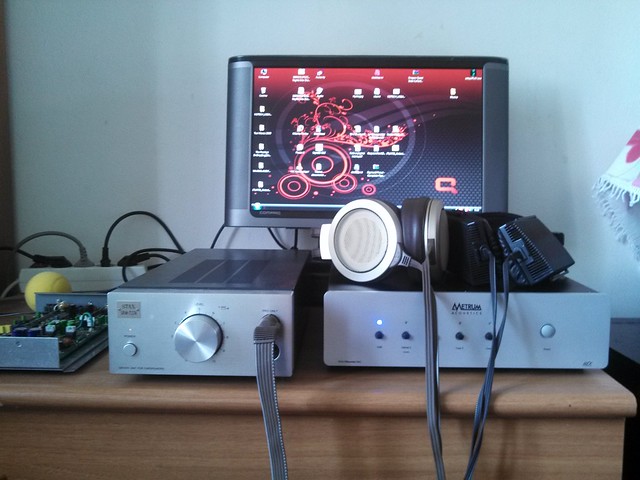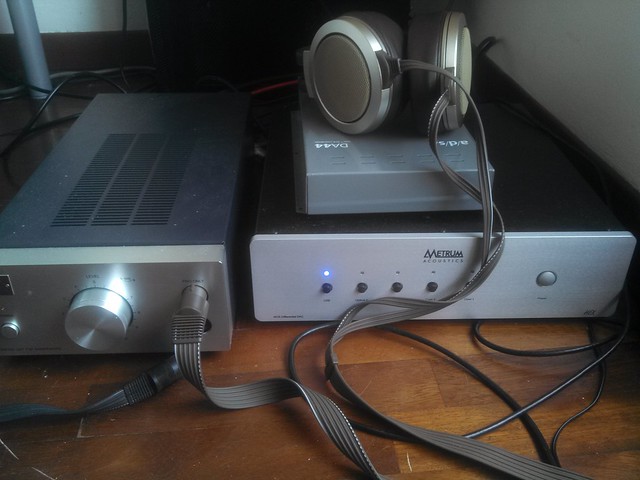Here I am reviewing one of the best sounding (if not the best sounding) DAC’s I have ever heard. It’s the Metrum Hex.
I have purchased this after having liked the Metrum Octave Mk2 quite a lot. In a convenient form factor, the Octave was offering a warm, lush, bloomy signature albeit a bit too smoothered and slightyl too centered on lower midrange. The overal tonality, though, was very very good and adaptable. For the same price, I was preferring my Museatex Idat-44m as more powerful in the deep bass, with better equilibrium bass too highs and slightly more realism in treble, while still being a warm source and feeling “matte”.
Anyway, the Hex was really interesting for me, for many reasons and I decided to jump on it, because it was bettering everything: dac section, usb input, and output (both the XLR and the RCA, with their Lundahl output transformers).

Specifications:
– Working principle: Non oversampling industrial high-speed dac chips. Dual mono, 8 Dacs per channel in differential mode.
– Power supply: 45 VA three separate toroid transformers to feed the DAC boards, control logic and USB. 18 V regulator
– USB nterfaces: custom-modded HiFace 2.0 with internal power supply and galvanic isolation, playback 44.1-192 kHz
– Slew rate: 35 Volt/µS
– Frequency response: 1Hz – 20 khz – 2.5 dB 44.1 kHz sampling rate; 1Hz – 65 kHz – 3dB 192 kHz sampling rate.
– Distortion: 0.03 % THD
– Noise: -130 dB related to 2 Volt RMS output.
Gear used:
– Sources: Metrum Hex, Idat44-m, Yulong DA8
– Amps: KGSS for Stax (actually a better version of the KGSS electrostatic amplifier, obtained by modifying the Stax SRM-727A with Kevin Gilmore’s indications)
– Headphones: Stax SR-007 Mk1, Stax SR-Lambda, Stax SRS-001 Mk2 (modded set)
Listening Impressions:
Where one could tend to associate an “analogue” sound to a low profile music approach, the Hex manages to sound analogue and “impressive” at the same time. It’s very realistic, brutally lively, and has exceptional 3D rendition.
The DAC is much better than its smaller sibling, the Octave Mk2. Their main resemblance is in tonal intensity (or color saturation, if you prefer). The Hex has much more deep bass power and dynamics, to the point that listening to the Lambda, you would never apply the word “light” to them. It’s a continuous exhibition of power. Where the Octave has some bloom in the upper bass, the Hex has a more linear midrange, with better distribution towards the higher frequencies, and much better extension towards both frequency extremes.
The biggest differences are in the treble. Where the Octave tends to be smooth, and lacks ultimate resolution, the Hex is super resolving. It offers a huge sense of layering, and super precise instrument placement. It has tons of information and follows micro-nuances with delicacy and clarity.
Similarly to the Yulong DA8, the Hex is an inspired and active “player”. But it’s warmer, more realistic, more romantic and complete than the Yulong DA8, and has superior spatial capabilities. By direct comparison, Yulong’s verve can be perceived as “electrical” by comparison.
When listening to the Lambda, the level of realism becomes much higher than listening something like the Mytek. The heft, dynamics, bass are all improved.
When listening to the Omega 2, anyway, the sound is more intense and darker, in a good way. Listening to the Omega 2 with the Metrum Hex, makes the Lambda sound slightly more washed out, by comparison. The Omega 2 enjoys strongly the tonal saturation the Hex has, and enjoy tremendously the 3D placement capabilities of the dac.
Also, the bass with the Omega 2 gains a lot compared to the Lambda. They hit very hard and suddenly, like they are already ‘there’ to hit. By comparison, the Lambda, when reproducing bass hits, sound like they are ‘running at you’ from a bigger distance, before actually hitting. It’s like a ramp, versus an impulse (with the Omega 2).
Bass is the only department where the Hex got exceeded by the Museatex Idat44m with Belkin Synapse Platinum coax digital cable. The Belkin synapse, brought to public attention by ‘Romy the Cat’ (who holds GoodSoundClub website), has as main characteristics a very powerful, super deep, textured and wide bass foundation, slight vocal recession.
With the Idat/Belkin configuration, the Omega 2 has an incredible bass response I found myself missing out partially with the Hex fed by the usb. I tried the Belkin on the Hex, and the difference got shortened was similar.
When using the Belkin, the Hex reminds me of a slightly more detailed Idat44. With the Usb, the Hex shows its best treble and instrument placement qualities in my system.
Comparing the Hex and the Idat44m, the Hex has better spatial capabilities, harmonic richness and widespread imaging, whereas the Idat accentuates more the central imaging. These observations are consistent both when the Hex is used with Usb, and when used with the Belkin cable (compared to the Idat, used with the Belkin).

Compared to the Eximus DP-1, the Hex offers a more realistic, powerful tone, symilarly lively imaging capabilities and details, better dynamics. The Eximus, while still very good and engaging, is quite a bit more standard and is not as ‘realistic’. Where the Eximus has slightly hotter upper midrange, the Hex midrange is uniformly prominent, and overall more linear and better integrated with bass and treble.
Conclusion
The Hex is the first no-compromise sounding dac I have come across, with the possible exception of the AMR DP-777 (which I hope to listen to more extensively, in the future). It betters the Octave in every way, as well as my ‘former favourite’ NOS dac, the Museatex Idat.
The stronger treble energy of the Hex (compared to both the Octave and the Idat) adapts very well to the Omega 2 with my KGSS-A amplifier. When using the Lambda’s, such difference is much less important. In fact, I might still have to try some good sounding silver cables (the Vh Audio for rca, or hunt around for some reliable high end XLR cables) to to extract a tiny bit more highs without screwing up the tonal balance, trying to overcome some limitations of my amplifier in taming the Omega 2 ‘fat’ qualities (they would rather deserve a Blue Hawaii SE or Srm-T2, but this is a different story).
I remember another reviewer calling the Hex like an “Octave on caffeine”. I quite like the definition. Anyway, at times the improvement and the wild dynamics are so wild that I would also describe it as “an Octave in need for exorcism”.
I would strongly advice towards buying it as the best sounding source I have come across in its price range. Other options could still be considered for several reasons, like the need of preamp functions (Eximus DP-1, AMR), or if in strong need of DSD reproduction, but the Hex gives really a lot for the money, if needing a pure DAC and not caring much for DSD.


